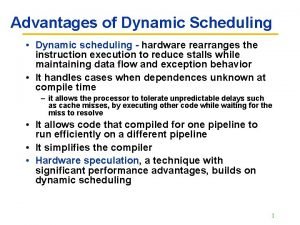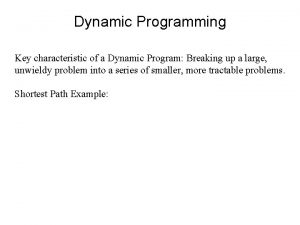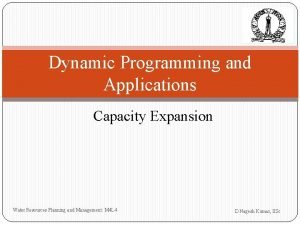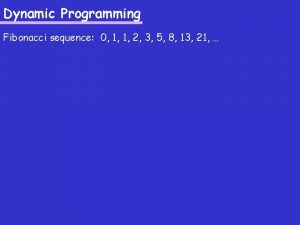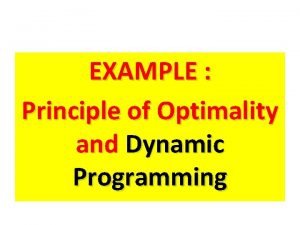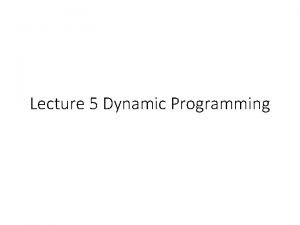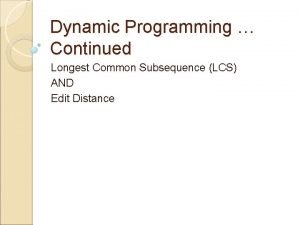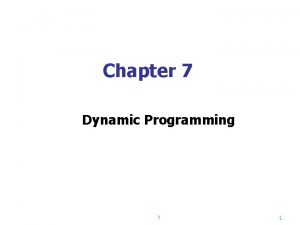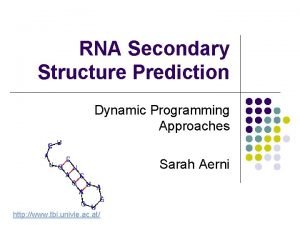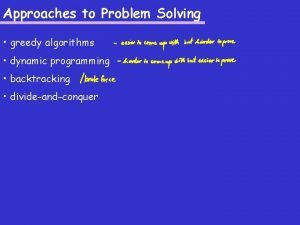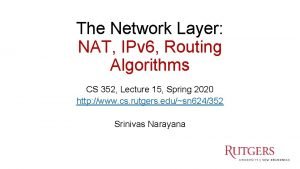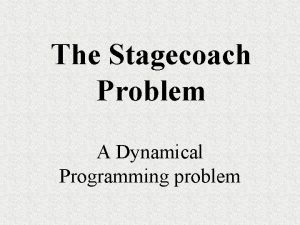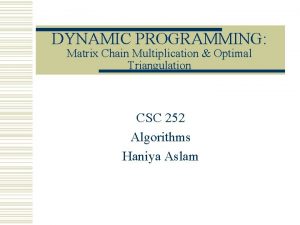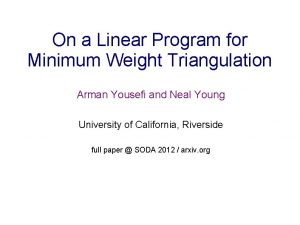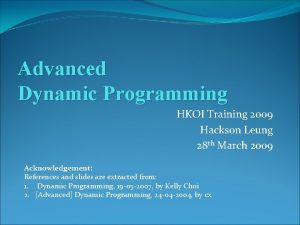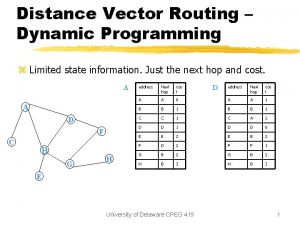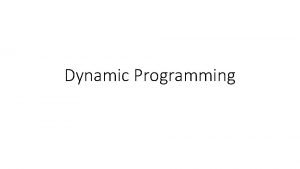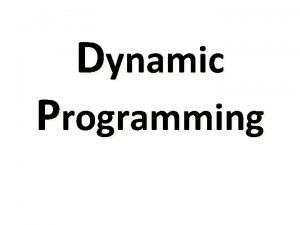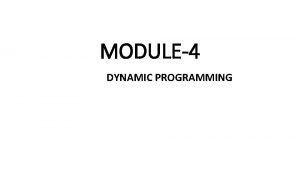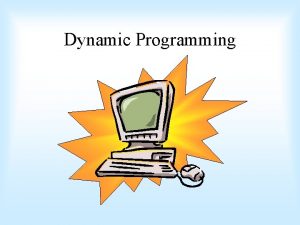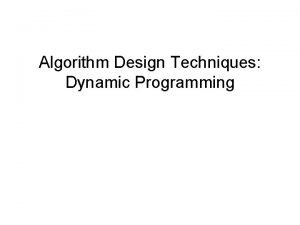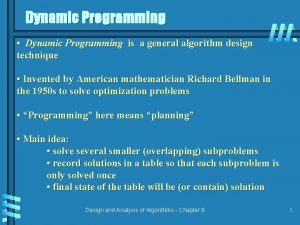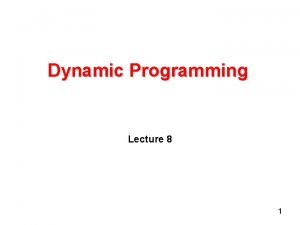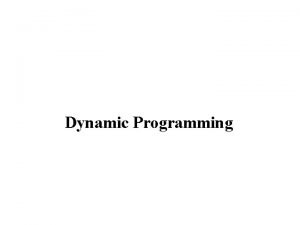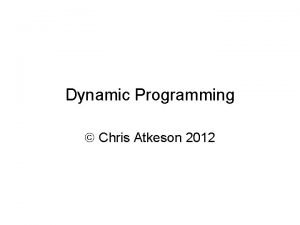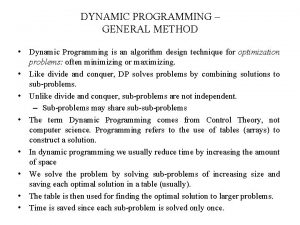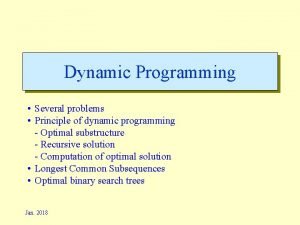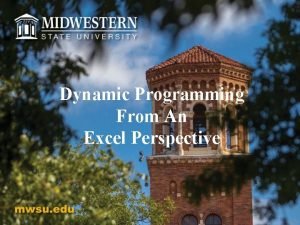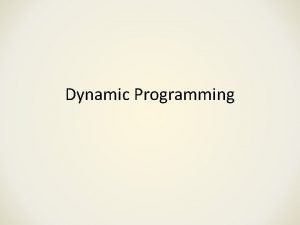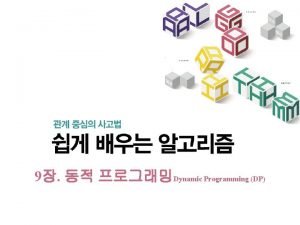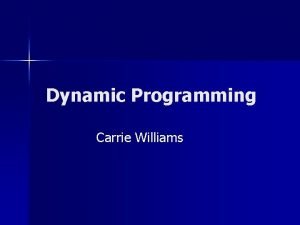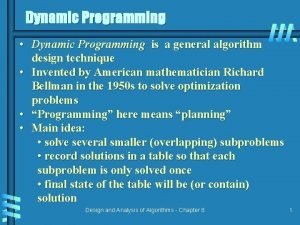Dynamic Programming Dynamic Programming Dynamic Programming is a



![Assembly-line scheduling Recursive equation: where f 1[j] and f 2[j] are the accumulated time Assembly-line scheduling Recursive equation: where f 1[j] and f 2[j] are the accumulated time](https://slidetodoc.com/presentation_image_h2/4a8222ae6706d80f11e2d1588f5231d7/image-4.jpg)














- Slides: 18

Dynamic Programming

Dynamic Programming • Dynamic Programming is a general algorithm design technique • It breaks up a problem into a series of overlapping subproblems ( sub-problem whose results can be reused several times) • Main idea: - set up a recurrence relating a solution to a larger instance to solutions of some smaller instances - solve smaller instances once - record solutions in a table - extract solution to the initial instance from that table

Discussed topics • Assembly-line scheduling • Partition of Data Sequence • Route Segmentation and Classification for GPS data • Longest Common Subsequence (LCS)
![Assemblyline scheduling Recursive equation where f 1j and f 2j are the accumulated time Assembly-line scheduling Recursive equation: where f 1[j] and f 2[j] are the accumulated time](https://slidetodoc.com/presentation_image_h2/4a8222ae6706d80f11e2d1588f5231d7/image-4.jpg)
Assembly-line scheduling Recursive equation: where f 1[j] and f 2[j] are the accumulated time cost to reach station S 1, j and S 2, j a 1, j is the time cost for station S 1, j t 2, j-1 is the time cost to change station from S 2, j-1 to S 1, j

Partition of Data Sequence Partition of the sequence X into to K nonoverlapping groups with given cost functions f(xi, xj) so that the total value of the cost function is minimal:

Partition of Data Sequence G(k, n) is cost function for optimal partition of n points into k non-overlapping groups: Recursive equation:

Examples: Image Quantization Input Quantized Here, cost function is: Square Error Quantize value

Examples: Polygonal Approximation 5004 points are approximated by 78 points. Given approximated points M, errors are minimized. Given error ε, number of approximated points are minimized. Here, cost function is:

Examples: Route segmentation Ski Non-moving Running and Jogging Divide the routes into several segments by speed consistency Here, cost function is: Speed variance Time duration

Examples: Route classification Determine the moving type only by speed will cause mis-classification. Frequent Moving type dependency of 1 st order HMM

Examples: Route classification (cont. ) 1 st order HMM, maximize: mi : moving type of segment i Xi : feature vector (e. g. speed) Solve by dynamic programming similar with the Assembly-line scheduling problem

Longest Common Subsequence (LCS) Find a maximum length common subsequence between two sequences. For instance, Sequence 1: president Sequence 2: providence Its LCS is priden. president providence

How to compute LCS? Let A=a 1 a 2…am and B=b 1 b 2…bn. len(i, j): the length of an LCS between a 1 a 2…ai and b 1 b 2…bj With proper initializations, len(i, j) can be computed as follows.

Running time and memory: O(mn) and O(mn).


Time Series Matching using Longest Common Subsequence delta = time matching region (left & right) epsilon = spatial matching region (up & down) Recursive equation:

Spatial Data Matching using Longest Common Subsequence epsilon = spatial matching distance Recursive equation:

Conclusion Main idea: - Divide into sub-problems - Design cost function and recursive function - Optimization (fill in the table) - Backtracking
 Greedy algorithm vs dynamic programming
Greedy algorithm vs dynamic programming Dynamic dynamic - bloom
Dynamic dynamic - bloom Advantages of dynamic programming
Advantages of dynamic programming Gap strategy in dynamic programming
Gap strategy in dynamic programming Characteristics of dynamic programming
Characteristics of dynamic programming Dynamic programming recursion example
Dynamic programming recursion example Fibonacci with dynamic programming
Fibonacci with dynamic programming Dynamic problem
Dynamic problem Knapsack dynamic programming pseudocode
Knapsack dynamic programming pseudocode Longest common subset
Longest common subset Multistage graph example
Multistage graph example Rna secondary structure dynamic programming
Rna secondary structure dynamic programming Dynamic programming
Dynamic programming Dynamic programming equation
Dynamic programming equation Stage coach problem
Stage coach problem Dynamic programming vs divide and conquer
Dynamic programming vs divide and conquer Minimum weight triangulation dynamic programming
Minimum weight triangulation dynamic programming Dynamic programming bottom up
Dynamic programming bottom up Dynamic programming
Dynamic programming


